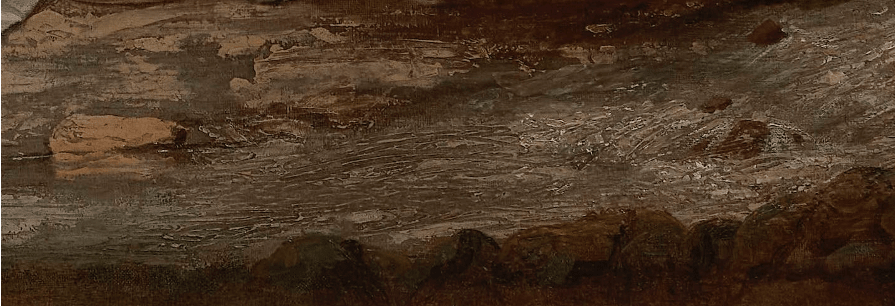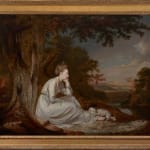 Fig. 1
Joseph Wright of Derby (1734 – 1797)
Fig. 1
Joseph Wright of Derby (1734 – 1797)Maria
Oil on Canvas: 39½ x 49½ in.
Painted 1777
Ferens Art Gallery, Kingston upon Hull.
This painting is the companion to The Captive, from Sterne (Vancouver Art Gallery).
Both were offered by ‘Bird’, Christie’s, 11 March 1780, lots 98 & 99.
 Fig. 2
Joseph Wright of Derby (1734 – 1797)
Fig. 2
Joseph Wright of Derby (1734 – 1797)Maria, from Sterne
Oil on canvas: 63 x 45½ in.
Signed and dated ‘1781’
Derby Museum and Art Gallery.
This painting is the companion to Edwin, from Dr. Beattie’s Minstrel, 1778 (Hambros Bank Ltd.), sold at Wright’s studio sale, Christie’s, 6 May 1801, lot 49.
 Fig. 4
Joseph Wright of Derby (1734 – 1797)
Fig. 4
Joseph Wright of Derby (1734 – 1797)[Detail] Rocks with Waterfall
Private collection.
 Fig. 5
[Detail of the present painting]
Fig. 5
[Detail of the present painting]Maria from Sterne’s Sentimental Journey
Joseph Wright of Derby A.R.A.
Further images
Provenance
(Probably) Anonymous sale; Christie’s, 27 April 1793, lot 74 (as ‘Maria from Sterne’, its pendant, ‘The Captive King from Sterne’, lot 75);
(Probably) Anonymous sale; unknown auction house at 25 Conduit Street, London, 24 March 1809, lot 50 (as ‘Maria, from Sterne’);
Henry A. Rannie (1828 - 1904), 11 Nelson Terrace, Hillhead, Glasgow;
Christie’s, London, 12 March 1898, lot 64 (as ‘A. Kauffman (Style of) - A Lady with a Dog, seated in a landscape’), 11gns; bt. by Frick
(Possibly) Henry Clay Frick (1849 - 1919), London;
Private collection, Spain;
Private collection, United Kingdom.
The reader finds Maria struck with grief at the departure of her lover:
When we had got within half a league of Moulines, at a little opening in the road leading to a thicket, I discovered poor Maria sitting under a poplar – she was sitting with her elbow in her lap, and her head leaning on one side within her hand – a small brook ran at the foot of the tree…
She was dress’d in white and much as my friend described her, except her hair hung loose, which before was twisted with a silk net. – She had, superadded likewise to her jacket a pale green ribband, which fell across her shoulder to the waist; t the end of which hung her pipe. Her goat had been as faithless as her lover; and she had got a little dog in lieu of him, which she had kept tied by a string to her girdle; as I look’d at her dog, she drew him towards her with the string. “Thou shalt not leave me Sylvio,” said she. I look’d in Maria’s eyes, and saw that she was thinking more of her father than of her lover or her little goat; for as she utter’d them, the tears trickled down her cheeks.
The subject of the melancholy Maria became popular with late 18th century British artists and was painted by Wright of Derby, Angelica Kauffmann, Daniel Gardner and John Russell.
There are two differing compositions of Maria by Wright of Derby (Figs. 1 & 2) in public collections. Additionally, there are several early references in auction catalogues that suggest Wright of Derby made at least three or possibly four versions Maria, from Sterne, with two having further pendants such as, The Captive, from Sterne. The technique of our painting is extremely distinctive. Large areas of the landscape appear to have been painted directly with a palette knife or a spatula. This can be seen most clearly in the trunk of the tree and landscape behind the figure. The handling is very similar to an experimental landscape, Rocks with Waterfall (Private collection) on loan to Derby Museum and Art Gallery and illustrated in the Tate 1990 exhibition catalogue (Figs. 3 & 4). Notably, there are numerous pentimenti visible to the naked eye, on Maria’s back and in the top of her hair showing the artist adjusting slightly the outline and design of the figure as he painted.
There is a big difference in the overall handling and mood between this painting and the Ferens version. Our canvas has bold, thick passages of paint applied with a tool then scraped and modelled to give it texture. It also has far stronger tonality and a richer color range. The Ferens painting by contrast is more classical, subdued and softly handled – more akin to the work of other late 18th century landscape painters such as Richard Wilson. Our version is far more dramatic, with stronger light/dark contrasts and more forceful brushwork. There are also minor differences in the design and details in the landscapes. In the versions there are differences in the topography of the hills in the far distance, the reflected water and the trees to the far right. Perhaps for the Royal Academy (Ferens) Wright painted a more conventional landscape specifically for exhibition purposes. Whereas, in our version he felt free to paint it in the manner of his choosing.
Another technique that is very typical and distinctive of Wright’s work is his use of sgraffito. This is the technique of removing wet paint with a stylus, such as the end of the brush to reveal the dried, previously applied colour beneath. This is something that Wright employed extensively in his landscapes, particularly for reflections on water, after his trip to Italy in 1773 - 1775. It is considered a signature technique of the artist. In our painting this sgraffito technique using the end of the brush can be seen in this passage of the water just above the flowing brook and in the white water of the brook itself (Fig.5). It is worth noting that in the absence of a signature, the use of this sgrafitto technique is often considered the sign of an autograph work.
The known provenance of the present painting adds further intrigue to the present painting. It is probably identifiable with the canvas offered at Christie’s, 27 April 1793, as lot 74, ‘Maria from Sterne’ along with a pendant, ‘The Captive King from Sterne’, lot 75. It was probably offered again, without its pendant, at an unknown auction house on 24 March 1809, [25] Conduit-Street, London, as lot 50, ‘Maria, from Sterne’. Our painting is next recorded in the collection of H.A. Rannie of 11 Nelson Terrace, Hillhead, Glasgow who was a successful and wealthy Glasgow businessman. He sold the painting at Christie’s on 12 March 1898, as lot 64, ‘A. Kauffman (Style of) / A Lady with a Dog, seated in a landscape’ 11 11gns where it sold for 11gns to a ‘Frick’. It is possible that the buyer was the famed collector Henry Clay Frick (1849 - 1919) who was already buying Old Masters and 19th century European paintings at this time. The painting is subsequently recorded as being in a private collection in the United Kingdom during the 20th century.





